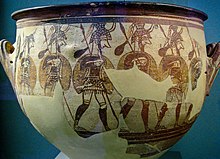Warrior Vase
The Mycenaean Warrior Vase, found by Heinrich Schliemann on the acropolis of Mycenae, is one of the prominent treasures of the National Archaeological Museum, Athens.
[1] The Warrior Vase is probably the best-known piece of Late Helladic pottery, though its dating, to the 13th or 12th century BCE, has been the subject of much discussion.
[2] It is a krater, a mixing bowl used for the dilution of wine with water, a custom which the ancient Greeks believed to be a sign of civilized behavior.
The warriors are clad in short chitons, breastplates, helmets and greaves; they are armed with spears and carry shields.
The bull's head handles for long encouraged scholars to date the piece later, in the early seventh century BCE.

